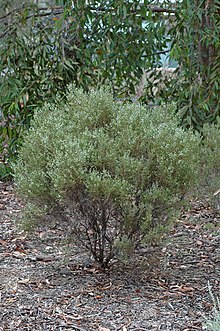| Olearia microdisca | |
|---|---|

| |
|
Scientific classification
| |
| Kingdom: | Plantae |
| Clade: | Tracheophytes |
| Clade: | Angiosperms |
| Clade: | Eudicots |
| Clade: | Asterids |
| Order: | Asterales |
| Family: | Asteraceae |
| Genus: | Olearia |
| Species: | O. microdisca
|
| Binomial name | |
| Olearia microdisca | |

Olearia microdisca, commonly known as small-flowered daisy-bush, [2] is a species of flowering plant in the family Asteraceae and is endemic to Kangaroo Island, South Australia. It is a compact shrub with small, crowded, oblong leaves and white and yellow, daisy-like inflorescences.
Description
Olearia microdisca is a compact shrub that typically grows to a height of up to 1.5 m (4 ft 11 in) and has many softly-hairy branches. Its leaves are crowded, sometime overlapping each other, oblong 1.5–2.5 mm (0.059–0.098 in) long, about 1 mm (0.039 in) wide and sessile. The upper surface of the leaves is glabrous, the lower surface is woolly-hairy and the edges are rolled under. The heads or daisy-like "flowers" are arranged singly on the ends of erect branches and sessile. Each head has two to five white ray florets, the ligules about 3 mm (0.12 in) long, surrounding two or three yellow disc florets. Flowering occurs in most months and the fruit is a softly-hairy achene, the pappus about 2 mm (0.079 in) long with 25 to 35 bristles. [3]
Taxonomy
Olearia microdisca was first formally described in 1928 by John McConnell Black in Transactions and Proceedings of the Royal Society of South Australia. [4] [5]
Distribution and habitat
Small-flowered daisy-bush grows in heath and mallee and is restricted to Kangaroo Island in South Australia. [2] [3]
Conservation status
Olearia microdisca is listed as "endangered" under the Australian Government Environment Protection and Biodiversity Conservation Act 1999. A recovery plan for nationally threatened plant species on Kangaroo Island, including O. microdisca, has been prepared. [6] [7]
References
- ^ "Olearia microdisca". Australian Plant Census. Retrieved 25 May 2022.
- ^ a b Holliday, Ivan. "The genus Olearia". Australian Native Plants Society (Australia). Retrieved 25 May 2022.
- ^ a b "Olearia microdisca". State Herbarium of South Australia. Retrieved 25 May 2022.
- ^ "Olearia microdisca". APNI. Retrieved 25 May 2022.
- ^ Black, John M. (1928). "Additions to the Flora of South Australia. No. 26". Transactions and Proceedings of the Royal Society of South Australia. 52: 229. Retrieved 25 May 2022.
- ^ "SPRAT profile Olearia microdisca". Australian Government Department of Agriculture, Water and the Environment. Retrieved 25 May 2022.
- ^ "Recovery plan for nationally threatened plant species on Kangaroo Island South Australia" (PDF). Australian Government Department of Agriculture, Water and the Environment. Retrieved 25 May 2022.
| Olearia microdisca | |
|---|---|

| |
|
Scientific classification
| |
| Kingdom: | Plantae |
| Clade: | Tracheophytes |
| Clade: | Angiosperms |
| Clade: | Eudicots |
| Clade: | Asterids |
| Order: | Asterales |
| Family: | Asteraceae |
| Genus: | Olearia |
| Species: | O. microdisca
|
| Binomial name | |
| Olearia microdisca | |

Olearia microdisca, commonly known as small-flowered daisy-bush, [2] is a species of flowering plant in the family Asteraceae and is endemic to Kangaroo Island, South Australia. It is a compact shrub with small, crowded, oblong leaves and white and yellow, daisy-like inflorescences.
Description
Olearia microdisca is a compact shrub that typically grows to a height of up to 1.5 m (4 ft 11 in) and has many softly-hairy branches. Its leaves are crowded, sometime overlapping each other, oblong 1.5–2.5 mm (0.059–0.098 in) long, about 1 mm (0.039 in) wide and sessile. The upper surface of the leaves is glabrous, the lower surface is woolly-hairy and the edges are rolled under. The heads or daisy-like "flowers" are arranged singly on the ends of erect branches and sessile. Each head has two to five white ray florets, the ligules about 3 mm (0.12 in) long, surrounding two or three yellow disc florets. Flowering occurs in most months and the fruit is a softly-hairy achene, the pappus about 2 mm (0.079 in) long with 25 to 35 bristles. [3]
Taxonomy
Olearia microdisca was first formally described in 1928 by John McConnell Black in Transactions and Proceedings of the Royal Society of South Australia. [4] [5]
Distribution and habitat
Small-flowered daisy-bush grows in heath and mallee and is restricted to Kangaroo Island in South Australia. [2] [3]
Conservation status
Olearia microdisca is listed as "endangered" under the Australian Government Environment Protection and Biodiversity Conservation Act 1999. A recovery plan for nationally threatened plant species on Kangaroo Island, including O. microdisca, has been prepared. [6] [7]
References
- ^ "Olearia microdisca". Australian Plant Census. Retrieved 25 May 2022.
- ^ a b Holliday, Ivan. "The genus Olearia". Australian Native Plants Society (Australia). Retrieved 25 May 2022.
- ^ a b "Olearia microdisca". State Herbarium of South Australia. Retrieved 25 May 2022.
- ^ "Olearia microdisca". APNI. Retrieved 25 May 2022.
- ^ Black, John M. (1928). "Additions to the Flora of South Australia. No. 26". Transactions and Proceedings of the Royal Society of South Australia. 52: 229. Retrieved 25 May 2022.
- ^ "SPRAT profile Olearia microdisca". Australian Government Department of Agriculture, Water and the Environment. Retrieved 25 May 2022.
- ^ "Recovery plan for nationally threatened plant species on Kangaroo Island South Australia" (PDF). Australian Government Department of Agriculture, Water and the Environment. Retrieved 25 May 2022.
